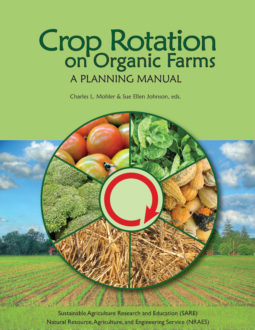To ensure that this rotation planning manual reflects the realities of crop production on actual farms, the New England Small Farm Institute, on behalf of the Northeast Organic Network (NEON), assembled a panel of 12 expert organic farmers. The panel met for three days and worked through a formal facilitated process that produced a detailed analysis of how experienced organic farmers plan their cropping sequences. This process is discussed in chapter 2. Each expert farmer also detailed a highly successful crop rotation that they use, along with problems that sometimes occur with that rotation and how they meet such contingencies. These sample rotations are presented in chapter 4 and are supplemented with rotations from several farms that have been intensively studied by NEON. These sample rotations may not work well on farms that have different soil conditions, climates, financial resources, or types of crops, but they are intended to provide inspiration and insight in planning crop sequences.
Chapters 2 and 4 convey the practical experience of expert growers. In contrast, chapter 3 emphasizes the theoretical underpinnings of crop rotation. Five researchers who have extensive experience with organic agriculture provide their views on what crop rotation contributes to particular biological and physical aspects of organic cropping systems, including management of soil health, crop nutrition, diseases, insects, and weeds. An important aspect of these contributions is that they clarify what crop rotation cannot accomplish, as well as what it can do to solve various production problems.
Chapter 5 outlines procedures for sorting through the diverse types of data to arrive at decisions about crop rotation. These procedures distill the wisdom derived from the panel of expert growers into a method that can be applied to any farm. Step-by-step examples are provided.
Although this manual is primarily intended for organic farmers and the extension personnel who work with them, we hope it will also be useful to other growers. To this end, chapter 6 provides a brief discussion about crop sequences that can be used for transition from conventional to organic production.
Intercropping is not a necessary part of crop rotation, but intercropping greatly affects crop rotation planning. Consequently, chapter 7 discusses the basic principles of intercropping and how these interact with other aspects of crop rotation.
Finally, a series of appendices provide biological data relevant to planning crop rotations. These data have been assembled from a variety of sources, including scientific literature, extension publications, and farmer experience.
This manual is most applicable for farms from Maryland to Ohio and north through southern Canada. Most of the principles of crop rotation and methods for choosing among potential crop sequences are widely applicable beyond this region. Data tables on crops, weeds, insects, and diseases, however, are likely to be inadequate in areas far from the northeastern US.
